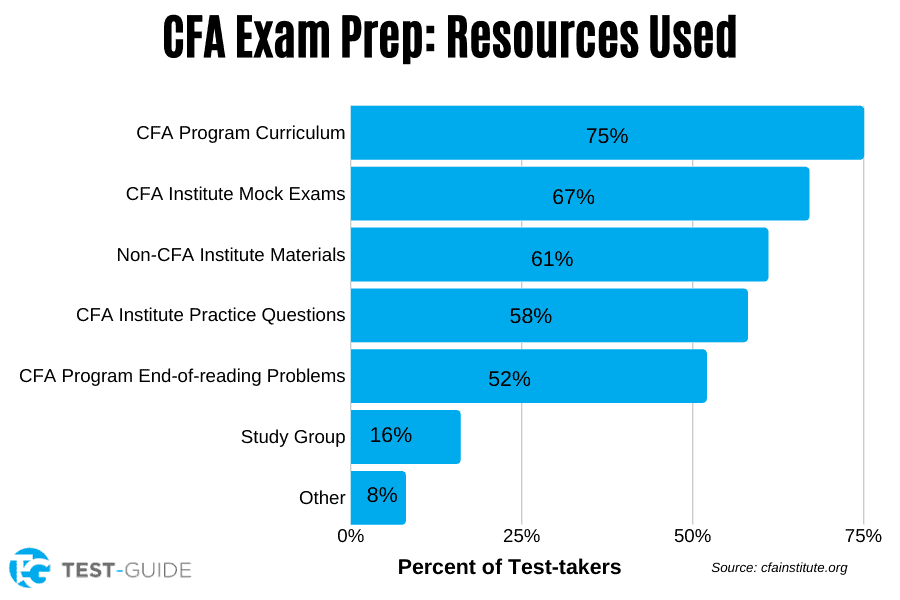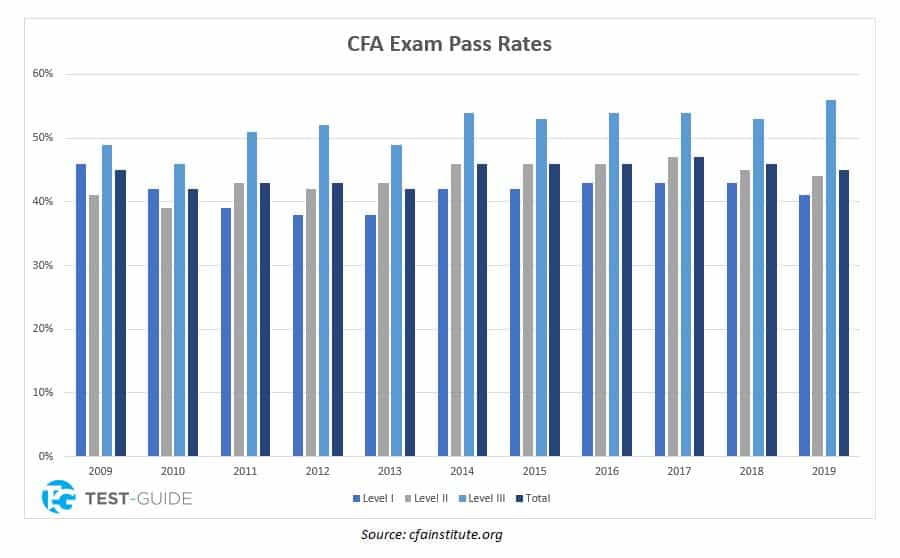To obtain many jobs in the financial industry, there are basically two routes. First, you can go back to school and learn your MBA. But for people who need to work full-time, this isn’t always an option.
Instead, you can become a Chartered Financial Analyst® (CFA). To earn this certification, you’ll need to pass the CFA exam, similar to how you’d need to pass the CPA exam to become an accountant.
The exam consists of three different tests: Level I, Level II, and Level III. Here’s a complete guide on how the exam works.
Summary: Utilize the resources below to help pass the CFA exam.
CFA Exam Prep – Recommended Study Resources
Most CFA exam experts recommend preparing for a minimum of 300 hours. That said, this can vary considerably based on your background. For example, if you’re already working as a stock broker, much of the information on the exam is already second nature to you. Regardless of your background, you’re going to want to take a practice test to see where you stand.
For most professional and academic exams, there are a lot of free resources available for prospective test-takers. But for the CFA exam, virtually all resources are paid. To help, we’ve dug up a few free options to go along with the paid offerings. Here are some resources that can help you succeed:
- To begin with, you’ll need to visit the official CFA Institute registration page, in order to sign up for your test.
- The Princeton Review offers a complete self-guided course, complete with slides, lectures, and mock exams.
- Fitch Learning offers a mix of free and paid study resources, including free sample lectures.
- Wiley CFA provides a paid study course. It’s pricey, but it offers a lot of premium features, including 17 weeks of live online classes.
- Bloomberg also offers a paid test prep program. However, theirs comes with a free 14-day trial period, so you can see if it works for you.
- If you’re looking for a more affordable option, check out AnalystPrep. They offer video lessons, mock exams, and question banks at a very reasonable price.
For more help, check out our free CFA practice questions resource.
Surveys from the CFA Institute show that most candidates use multiple resources to prepare for the exam.
CFA Exam Content Outline
The exact format of the CFA exam changes slightly from year to year. As a result, we can only speak with 100 percent certainty about the latest exam. This year’s Level I exam consists of 240 multiple-choice questions. Because of the large number of questions, the test is administered in two separate 3-hour sessions, one in the morning, and one in the afternoon.
Test questions are divided into ten different sections. These are:
- Ethical and Professional Standards
- Quantitative Methods
- Economics
- Financial Reporting and Analysis
- Corporate Finance
- Equity Investments
- Fixed Income
- Derivative Investments
- Alternative Investments
- Portfolio Management and Wealth Management
The different sections are weighted, so not all questions are worth the same amount. The CFA Institute also changes the weighting from year to year. Once again, we can only speak for sure about the latest exam. Here’s a quick look at the weighting:
| Section | Exam Weight |
| Ethical and Professional Standards | 15% |
| Financial Reporting and Analysis | 15% |
| Equity Investments | 11% |
| Fixed Income | 11% |
| Quantitative Methods | 10% |
| Economics | 10% |
| Corporate Finance | 10% |
| Portfolio Management and Wealth Management | 6% |
| Derivative Investments | 6% |
| Alternative Investments | 6% |
CFA Exam Administration
The CFA Exam is administered three times a year: in June, December, and February. Regardless of which session you register for, you need to pay a registration fee. This fee varies based on when you register. If you sign up a year in advance, you’ll get an early bird discounted rate of $650.
The normal fee is $950. If you register after August 19th, you’ll pay an increased fee of $1,380. Keep in mind that this fee applies for each level of the test. There’s also an additional $450 registration fee the first time you sign up. So assuming you pay the normal fee and pass each level the first time, you’ll pay a total of $3,300. That’s pricey, but it’s a lot less expensive than an MBA.
In 2020, the CFA exam is a pencil and paper exam. Beginning in 2021, it’s going to be administered on a computer instead. The format will also change. Instead of 240 questions, there will only be 180, but the sessions will be shortened from 3 hours to 2 hours and 15 minutes.
CFA Exam Requirements
Unlike many professional exams, the CFA does not require a college degree. If you have four years of full-time work experience in the financial industry, you can still sit for the exam. You can also sit for the exam if you have a combination of college and work experience totaling four years.
Finally, bachelor’s degree holders and fourth-year bachelor’s degree students can also take the exam.
Other than that, the only other requirement to take the exam is that you need to have a valid passport. Make sure to bring this passport with you on exam day, or you won’t be able to take the exam.
CFA Exam Scores
The CFA exam is a professional exam, not an academic exam. As a result, there are only two scores a candidate can receive: “pass”, or “did not pass”. Individual candidates can also see a detailed breakdown of their performance in each section.
That said, candidates cannot see their results for individual questions. This is one reason why it’s so important to take practice tests for preparation.
Individual candidates can also view their percentile rank amongst all test takers, and submit an appeal to the CFA Institute to have their test results retabulated. Percentile rank and test performance will never be released to a third party for any reason.
However, the CFA Institute does provide a list of passing test takers to professional organizations.
Test results are available within 60 days of the Level I and Level II exam. For the Level III exam, results can take up to 90 days. The results are available online for one year after the test. After that, the results will no longer be available. However, you can still request an official letter from the CFA to confirm that you passed the test.
As soon as test results are released, candidates can register for the next exam level. If you didn’t pass, you can re-register for the same level immediately. You can re-take any level of the CFA exam an unlimited number of times, so a “did not pass” result is not the end of the world.
Exact passing scores vary from year to year. The CFA Institute Board of Governors set the minimum score each year, as soon as the last year’s results have been tabulated. This is similar to a college exam that’s graded on a curve, to ensure fairness to all candidates.
That said, the minimum passing score is not public knowledge. It’s proprietary information known only to the CFA Institute.
CFA Exam Pass Rates
The most recent CFA Pass Rates are shown in the chart below.
CFA Exam FAQs
What is the CFA exam pass rate?
The exact CFA exam pass rate varies slightly from year to year. For December of 2019, the pass rate for Level I was 42%. Of candidates who register for the Level I exam, 20% ultimately complete all three levels.
Are CFA prep courses worth the money?
The CFA exam has 3 levels, all of which are challenging. Earning a CFA designation will accelerate any career. Making an investment in a CFA prep course will pay dividends in the long run.
What is on the CFA level 1 exam?
The CFA exam is always changing. Last year’s CFA level I exam consisted of 240 multiple-choice questions and was made up from ten different sections.
What is a CFA exam?
CFA stands for chartered financial analyst. The exam is taken by applicants, usually investment or financial professionals, who wish to achieve the CFA professional designation. There are 3 levels of the CFA exam.



